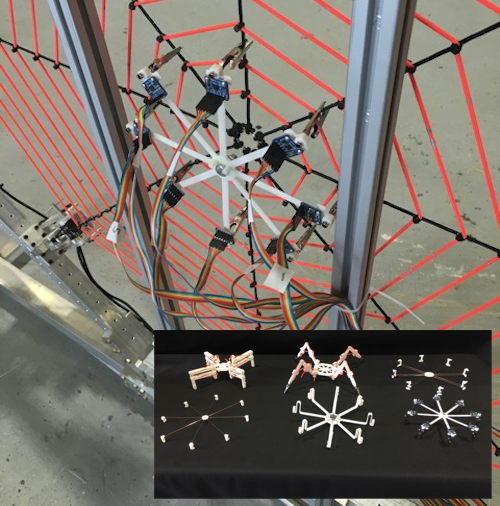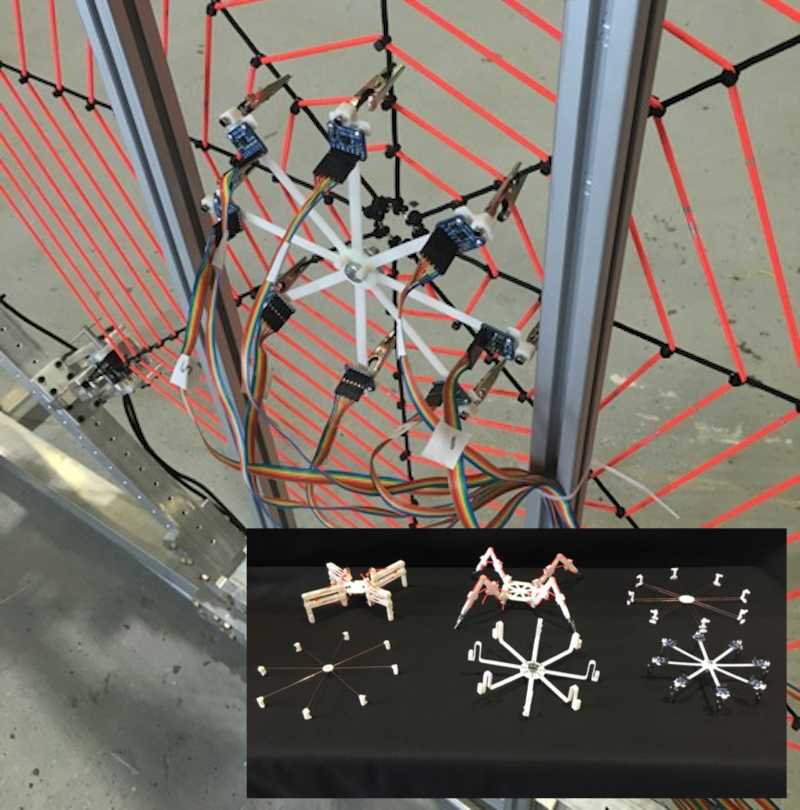Highlights from the APS March Meeting 2016
Nearly 10,000 physicists attended the American Physical Society’s March Meeting in Baltimore. The conference is focused on condensed matter, and, according to the APS scheduler app, the topics with the biggest draw were Majorana fermions, topological insulators, and quantum computing. But several talks described research outside the bounds of traditional condensed matter, like using electric fields to make low-fat chocolate and testing dark-energy models with an atom interferometer. To top it off, Fidel Castro Díaz-Balart, Fidel Castro’s son, spoke about increasing collaboration between researchers in the U.S. and Cuba (see story in APS News). Here’s a sampling of some of the many presentations we heard at the meeting.
–Katherine Wright, David Ehrenstein, and Jessica Thomas
Artificial Spider Webs
Given its poor vision, a spider relies on the vibrations of its web to identify and locate prey, predators, and potential mates. To study how spiders gain information from web vibrations, Ross Hatton, of Oregon State University in Corvallis, and his colleagues built a 6-foot-diameter spider web in their lab using rope for radial “spokes” and bungee cord for the perpendicular, spiral elements. They vibrated one spoke with a subwoofer speaker and detected the vibration amplitudes on each spoke (including the vibrated one) with a centrally located, scaled-up spider model that had eight detector “legs.” The team expected the vibration amplitude to decrease with distance from the vibration source, which is what they found at frequencies below the primary resonant frequency of the web. But at higher frequencies, they were surprised to learn that each spoke had a characteristic frequency at which it nearly stopped vibrating. Hatton says that spiders might use this effect for localization, and he and his colleagues are in the process of identifying other potential tricks a spider could use.
Report on LGBT Physicists
APS created an LGBT committee in 2014 to assess the climate for LGBT physicists and to make recommendations for improvement. To gather data, the committee ran focus groups and conducted interviews and surveys. In its final report, released at a March Meeting press conference, the committee says that the climate is so frequently unpleasant that over one-third of LGBT survey respondents considered leaving their jobs in the previous year. Half of transgender respondents experienced harassment on the job, and a significant fraction of all LGBT physicists observed or experienced exclusionary behavior, such as mocking or disparaging comments. The group also found that feelings of isolation were common and that identifying supportive allies within physics departments was often challenging. Among its recommendations, the committee calls on APS to create a new Forum on Diversity and Inclusion to support long-term efforts such as mentoring, education, and advocacy for all minority and marginalized groups in physics, including women, ethnic minorities, LGBT people, and others.
Printing Durable 3D Objects
If you can draw it, a 3D printer can create it. In extrusion 3D printing, polymer strips are placed side by side and on top of one another and then fused together. But the printed object can lack structural stability if the layers don’t properly bond or the polymer strips contain imperfections. Edward Duranty and colleagues from the University of Tennessee have been working on ways to improve material bonding and reduce defects so that 3D printing can be used to create longer-lasting parts with enhanced structural integrity. To print, the polymer “ink” is deposited in liquid form and needs to stay liquid while the next layer is printed so that the layers fully bond, leaving no weak points. To keep the ink liquid, the surface on which printing occurs is heated just above the polymer solid-liquid transition temperature. This works for the first couple of layers, but the researchers found that, because of poor thermal conduction, subsequent layers hardened before the next could be deposited. To mitigate the problem, they applied a chemical cross-linker to the surface of each layer after it was printed. This approach increased the interfacial adhesion between layers and the overall integrity of the printed object.
Modeling Epidemics
Will next year bring a flu pandemic? What strains of flu should be vaccinated for? How many more people will get sick if vaccine programs are delayed? These are the types of questions that physicists are helping organizations like the U.S. Centers for Disease Control and Prevention (CDC) answer. As soon as the first cases of flu are reported, models are set running to predict the spread of the disease and the impact of interventions like vaccinations. Martin Meltzer, who leads the Health Economics and Modeling unit at the CDC, discussed how data from these models are used to make informed decisions. Flu is a particularly hard disease to monitor because of the inaccuracy of rapid diagnostic tests—the likelihood of a correct diagnosis with a nose or throat swab can be as low as 50%. But without accurate data, officials won’t know when to start vaccinating, or whether to close schools or hospitals to limit infections. This is where physicists can step in, explained Meltzer. Using transmission data from the disease (if you fall ill with H1N1, for example, you will infect on average 1 to 2 people) and information on the initial outbreak, models that incorporate real human behaviors (such as daily routines) provide health authorities with estimates on the efficacy of interventions, along with the cost of delay.
Are Gentler Tumor Treatments Better?
The prevailing view of why some tumors stop shrinking under treatment and eventually grow back is that tumor cells mutate into a drug-resistant strain. Speaking at a session on the physics of cancer metastasis, Sui Huang of the Institute for Systems Biology in Seattle, Washington, presented an alternate perspective. Huang uses theoretical models—many rooted in the physics of networks and nonlinear dynamics—to describe the different ways in which cells with the same genetic code can behave. In these models, the traits a group of cells expresses tend to converge towards a stable point, or “attractor state,” in a multidimensional space. Huang’s hypothesis is that tumor cells not killed by treatment experience a severe stress, which distorts the landscape of attractor states. This may allow the cells to shift into a drug-resistant state, even without mutations. In recent experiments, he and his collaborators have found evidence that after chemotherapy a small number of surviving cells undergo this transition. Huang says that, if his hypothesis can be confirmed—and he acknowledged that it is “on the fringe”—it may support a movement to supplant aggressive tumor treatments with gentler approaches, such as less frequent, lower drug doses.





